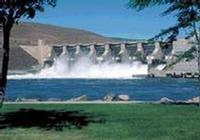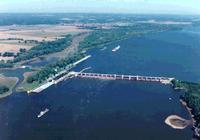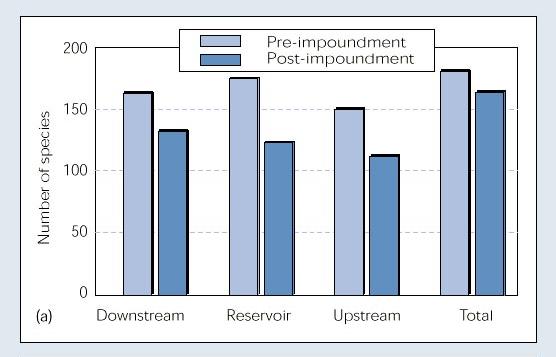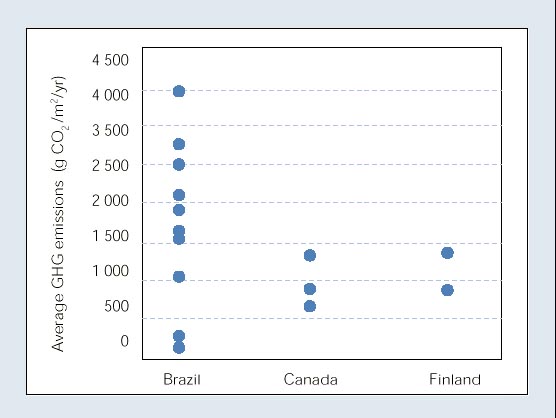|
|
|
|
| 1. INTRODUCTION |
|
Dams and river regulation have become an integral part of the landscape and economy of many countries. The last century has seen a rapid increase in the building of large dams (Fig. 1). Dams have altered the flow of rivers to meet societal needs. Regulated rivers have produced benefits such as hydropower, navigation, flood control, and drought mitigation. However, regulated rivers are different than untamed rivers in their physical and ecological properties. Channel shape, riverine, riparian and floodplain vegetation, and instream aquatic communities undergo marked changes following flow regulation. Environmental impacts of dams can be classified as follows:
Flow regulation below certain types of dams, such as water-supply reservoirs, results in artificially constant environments that lack natural extremes. Although productivity in a few species may increase, it is usually at the expense of a reduction in the number of native species and of ecosystem species diversity. Other negative impacts of dams include the impediment to fish migration, the alteration of natural seasonal flow variations that trigger growth and reproduction cycles in many species, the blocking of debris and nutrients, and an increase in predator risk. Logs and other debris are needed downstream as food and refugia habitat. Reservoirs disorient native fish and may accumulate heavy metals and other chemical pollutants.
|
|
| 2. TYPES OF IMPACTS |
|
Environmental impacts of dams are generally due to the existence of the reservoir and the pattern of dam operation. The impacts of large dams on ecosystems, biodiversity and downstream livelihoods may be substantial. Upstream of a dam, usually there is an imposition of a reservoir in place of a river valley. Engineered dams flood a vast area of land worldwide (about 400,000 km2). This includes terrestrial and aquatic ecosystems of every habitat type, including tropical rain forests with their rich biodiversity. Especially significant is the fact that the land lost is of importance out of proportion to its size, as it includes river and terrestrial habitats on floodplains and along river banks. Natural habitats are replaced by a relatively uniform reservoir, which usually provides habitat for a much smaller range of species. Changes in the downstream morphology of riverbed and banks, delta, estuary and coastline are due to changes in sediment load. Likewise, the impact of dams on downstream habitats is through changes in the sediment load. All rivers carry sediment as they continually erode their watersheds. When a river is held behind a dam for a period of time, most of the sediment is trapped in the reservoir. Water released by a dam will be clearer, with less sediment than it had upstream. Clear water below a dam is said to be "hungry," and it gains its sediment load by eroding the downstream bed and banks. Eventually, all the readily erodible material on the riverbed below the dam will be eroded away, leaving a rocky streambed and a poorer habitat for aquatic fauna. Erosion may also increase along the coast beyond the mouth of a river. The downstream river will also tend to become narrower and deeper, which may reduce the diversity of animal and plant species that it can support. Changes in downstream water quality has effects on river temperature, nutrient load, turbidity, dissolved gases, and the concentration of heavy metals and minerals. When river water is held in a reservoir for a period of time, the temperature changes, nutrients are removed, forests are flooded and subject to decomposition, and there may be colonization of the water by aquatic plants. Each of these effects may have an impact on the life that depends on that water. These effects are generally related to how long the water has remained in the reservoir. Severe effects can occur when a reservoir is first filled and submerged vegetation is subject to decomposition. As it decomposes, it will lead to oxygen depletion in the reservoir, which is lethal to fish. Mercury contamination is another water quality concern. While mercury is often present in an inorganic form in soil, once the soil is flooded, bacteria may transform this inorganic mercury into methylmercury, which is toxic and can be absorbed, concentrated, and passed up the food chain. Studies made in Canada have reported that in every case studied, the concentration of mercury in fish has increased from before to after reservoir implementation. Reduction of biodiversity is due to the blocking of movement of organisms and other impacts. The most significant environmental consequence of dams is that they tend to fragment river ecosystems, isolating populations of species living upstream and downstream of the dam, and cutting off migrations. More importantly, they block the migration of fish traveling upriver for purposes of hatching. In either case, the dam can be an enormous obstacle, often causing a great impact on fish populations.
|
| 3. GEOMORPHOLOGY |
|
Dams profoundly impact the geomorphology of rivers by altering the natural patterns of
water and sediment flow.
Geomorphological changes due to dams are less predictable than the changes in hydraulic parameters.
Geomorphological changes include channel degradation, aggradation, metamorphosis, width changes,
armoring and bend migration. These changes may have a negative impact on
aquatic and riparian ecosystems upstream and downstream of the dam.
Degradation, or a lowering of the channel bed, is the most immediate response to dam closure.
Erosion immediately below a dam and subsequent to dam closure has been commonly reported.
The erosional front migrates downstream until either the slope has adjusted or
roughness has increased to the stage at which critical shear stresses are below the threshold for
sediment transport. Bed degradation takes place the first few years after dam closure,
and subsides in later years.
Degradation may be inhibited by the formation of an armor layer.
Armoring is the phenomenon in which the median grain size of the bed gets coarser with time, as
the reduced flows winnow out the finer materials that they are competent to carry.
A single-grain thickness of
coarser material is sufficient to form an armor layer which limits degradation under normal flow conditions.
Aggradation, or deposition of sediments on the channel bed, is a result of the
redistribution of sediments in the channel below the dam. Redistribution occurs
from the erosion processes, and from the tendency for a narrower channel to form
because of the reduction in competence to carry available sediments.
The processes of aggradation and degradation can occur simultaneously
in a river below an impoundment, in different locations depending on local hydraulics,
sediment characteristics,
and geologic and vegetative controls. Therefore, the reach-by-reach characterization of the
downstream system is an important requirement for a predictive assessment.
In general, aggradation occurs immediately downstream of dams at much slower rates than degradation.
Studies of channel changes below dams have shown both channel widening and
channel narrowing, and this response is clearly site dependent.
Bank materials, slopes, and heights, and the interactions with
vegetation are important considerations. Channel narrowing can occur due to prolonged
periods of low flow, a reduction in sediment load, and/or vegetation encroachment.
Channel widening downstream of dams is generally due to bank failure. There are a range of
mechanisms which can be involved, depending on the peculiarities of the dam discharge
patterns. When bank materials are readily available for transport, bank erosion can occur after the
bed has stabilized due to armoring or bedrock exposure.
Scour due to wave action can erode banks, particularly in cases
where relatively high in-channel water levels is maintained for long periods of time in
regulated rivers. The sudden reduction in water level when turning off a power plant can cause
"drawdown-induced" erosion, the exact mechanisms of which depend on factors which
include seepage gradients and the role of vegetative roots in directing water
along preferred drainage pathways.
Fluctuations in pore-water pressures with alternating
wetting/drying cycles can affect soil strength and slope stability.
There are opposing tendencies at work in impounded rivers: The reduction in
sediment load promotes scour, while the reduction in transport capacity promotes sediment
deposition. The location, nature and rates of change will vary from
reach to reach depending on the local characteristics.
Vegetation and large woody debris have a role in stabilizing the channel perimeter and resisting geomorphic
change, and the sequencing of major flood events is critical in influencing the order of response events.
Long-term large-scale aggradation in riverbeds downstream of dams may be
due to the absence of floods resulting from dam operation.
|
| 4. SEDIMENTS |
|
Dams cause changes in stream hydrology and sediment transport.
Before dams are built, sediments are naturally flushed through
river systems by periodic floods. Impounding rivers generally
result in increased coastal erosion due to the reduction in sediment supply to estuaries.
Sediment loads are usually reduced by dam closure, because the impoundment
effectively traps any bed load delivered from upstream, and suspended sediments tend
to settle out in the reservoir. Most of the sediment load may be effectively trapped in this
manner. Bed load may still be supplied from tributaries downstream of the impoundment, and this
contribution can increase due to the impoundment. An increase in bed-material
load from tributaries can occur
because the baseflows in the main river downstream of the dam are often reduced when floods are
occurring in uncontrolled tributary streams, causing an increase in the water-surface gradient from the
tributaries, increasing their bedload transport. This phenomenon is known as "tributary rejuvenation."
Dams disrupt the equilibrium between the movement of water and the movement of sediment.
This disruption modifies the geomorphic features that constitute habitat for aquatic and riparian species.
Dams capture all but the finest sediments moving down a river, with significant consequences.
Sediment-depleted water released from dams can erode finer sediments in the downstream channel.
The eroding streambed in turn reduces habitat availability for many aquatic species
living in or using cobbled streambeds. In addition, eroding channels will downcut streambeds which
will increase tributary erosion upstream. Without high flushing flows, species with life stages
sensitive to sedimentation, such as eggs and larvae of many invertebrates and fish,
can suffer high mortality rates.
Downcutting of streambeds will isolate the floodplain from overbank flows,
degrading habitat for riparian and floodplain species.
|
| 5. NUTRIENTS |
|
The reduction in nutrient transport in rivers downstream of dams causes the loss of aquatic habitat for fish
and other species, and losses to agriculture.
The direct loss of annual silt and nutrient replenishment as a consequence of upstream impoundment is thought
to have contributed to the gradual loss of fertility of formerly productive floodplain soils as used in
agriculture, particularly those soils nurtured by the recession of the flood.
Dramatic reductions in bird species have also been reported, especially
in downstream floodplain and deltaic areas, where wetlands may not be replenished with water and nutrients
once a dam is in place.
The reduction in nutrients transported to the sea lowers production at all trophic levels, resulting
in a decline in catches of sardines and other fish.
|
| 6. FLORA AND FAUNA |
|
The impacts of reservoirs on terrestrial ecosystems and biodiversity is as follows: Upstream terrestrial ecosystems and biodiversity The construction of a dam and subsequent inundation of the reservoir area effectively kills terrestrial plants and forests and displaces animals. Many species prefer valley bottoms; therefore, a large-scale impoundment may eliminate unique wildlife habitats and affect populations of endangered species (Fig. 2).
|
|
|
Flooding a reservoir may lead to the occupation and clearing of upstream catchment
areas as replacement for land lost to the reservoir. This land-use change
has direct effects in terms of habitat loss, elimination of flora and
fauna and, in many cases, land degradation. It also has feedback effects on the reservoir
through alterations in hydrologic function. The resulting loss of vegetative cover leads
to increases in sedimentation, stormflow, and annual water yield, as well as to decreases in water
quality and changes in the seasonal timing of floods.
Downstream aquatic ecosystems and biodiversity
The extent of the impacts will depend on
whether water is diverted for consumption, or left instream. Ecologically modified river systems
experience invasion by non-native species, changes in water quality parameters
such as temperature, dissolved oxygen, and nutrient availability,
changes in energy flows, and loss of ecosystem natural services.
The establishment of a new equilibrium has positive effects on some species and negative on others.
Flow regime is the key driving variable for downstream aquatic ecosystems.
Flood timing, duration and frequency are critical for the survival of biological
communities living downstream.
Small flood events may act as biological triggers for fish and invertebrate migration.
Major events create and maintain habitats by scouring or transporting sediments.
The natural variability of most river systems
sustains complex biological communities that may be very different from those
adapted to the stable flows and conditions of a regulated river. Water temperature
and chemistry are altered as a consequence of water storage and the different timing of
downstream flows. Algal growth may occur in the reservoir and in the channel immediately
downstream from dams because of the nutrient loading of the reservoir releases.
Self-purification processes diminish this effect downstream.
Storage dams, particularly hydropower-peaking plants, can significantly disrupt the
flow regime, resulting in both high seasonal and day-to-day fluctuations that
differ greatly from natural flows. These changes in flow can dramatically
alter the riverine environment, producing consistently colder temperatures due to the
release of water from the reservoir bottom.
The modified habitats resulting from large dams may create environments that are
conducive to non-native and exotic plant, fish, snail, insect, and other animal species.
These non-native species may outcompete the native ones and end up
modifying ecosystems which may become unstable, nurture disease vectors, or eventually are no
longer able to support the historical environmental and social components. Many lake fish species
have successfully invaded artificially stabilized riverine environments.
Compared with a natural river, the root systems of plants in rivers below dams experience less scour.
The plants themselves suffer less stress from high discharges, and the rate of channel
migration is reduced. Therefore, areas of the channel bed can be stabilized and help
vegetation to become established.
When waters of one basin are diverted into another basin, changes in volume and seasonality
of flow result. New biota from the source basin may invade the recipient basin
and compete with the native species. When all the water is diverted from the source basin,
there will be serious impacts on unique species or genetically different stocks.
The reduction in sediment and nutrient transport in rivers downstream of dams has
impacts on channel, floodplain and coastal and deltaic geomorphology, and may cause the loss of
aquatic habitat for fish and other species. Changes in river water turbidity may affect
biota directly. For example, plankton production is influenced by many variables,
including turbidity.
Reduction in sediment moving downstream from the dam leads to degradation of the
river channel below the facility. This can lead to the elimination of beaches and
backwaters that provided native fish habitat, and the reduction or elimination of riparian
vegetation that provides nutrients and habitat for aquatic and waterfowl species,
among others.
As a physical barrier, a dam disrupts the movement of species, leading to changes in
upstream and downstream species composition and even species loss. River-dwelling
species have several migratory patterns. These include anadromous fish such as salmon and
catadromous fish such as eels. Anadromous adults migrate up rivers to spawn and the young
descend, while the reverse occurs with catadromous adults.
Moreover, the glochidia larvae of freshwater mussels are carried by host fish.
Aquatic insect
adults such as mayflies and stoneflies move upstream to lay their eggs
to help counteract the drift downstream of their larvae.
Dams block these migrations to varying degrees.
Changes in fisheries productivity at Tucurui dam, Brazil, is shown in Fig. 3.
|
|
|
Floodplain ecosystems
Reduction in downstream annual flooding affects the natural productivity of riparian
areas, floodplains, and continental and estuarine deltas.
The characteristics of riparian plant communities are
controlled by the interaction of flooding and sedimentation. Many riparian
species depend on shallow floodplain aquifers that are recharged during regular
flood events. Dams can have significant and complex impacts on downstream riparian
plant communities. While high discharges can retard the encroachment of true terrestrial
species, many riparian plants have evolved with and become adapted to the natural flood regime.
In large tropical rivers, the annual flood pulse serves as the primary agent
to preserve ecosystem health, maximize biotic productivity, and
maintain species diversity.
The control of floodwaters by large dams, which usually reduce flow during natural
flood periods and increase flow during dry periods, leads to an unnatural constancy in the river system.
This constancy, coupled with the loss of floodplain habitats by land reclamation, normally has a
marked negative impact on fish productivity and species diversity. The connection between
the river and floodplain is essential in the life history of
many riverine fish that have evolved to take advantage of the seasonal floods and use the
inundated areas for spawning and feeding. Loss of this connection can lead to a rapid
decline in productivity of local fisheries and to the extinction of some species.
Reductions in bird species are observed as natural wetlands are not replenished
with water and nutrients once a dam is in place. The recharge of groundwater in floodplain
areas normally diminishes once floods are eliminated.
Greenhouse gas emissions
The emission of greenhouse gases (GHG) from reservoirs due to rotting vegetation and
carbon inflows from the catchment has been recently identified as a possible impact of dams.
Large dams and natural lakes in the boreal and tropical regions are known to emit
greenhouse gases (carbon dioxide, methane, and sometimes both). Figure 4 shows the
range of values of gross GHG emissions for 15 reservoirs, recorded by field measurements.
However, measurements of net
GHG emissions are still in their infancy; more research is needed to determine their impact.
|
|
| 7. SUMMARY |
|
| http://ponce.sdsu.edu/environmental_impact_of_dams.html | 040913 |





